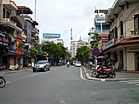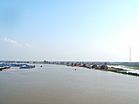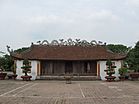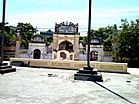Hải Dương province facts for kids
Quick facts for kids
Hải Dương province
Tỉnh Hải Dương
|
|
|---|---|
| From left to right: Lychee garden Thanh Ha • Main street Trần Hưng Đạo • Mạc Đĩnh Chi Temple in Nam Sách District • Lục Đầu River flowing through Chí Linh City • Bạch Đằng River • Sượt Temple • Hải Dương Cathedral • Bảo Sái Temple • Hải Dương Museum • Hải Dương Theater | |
| Nickname(s):
Ocean sun
|
|
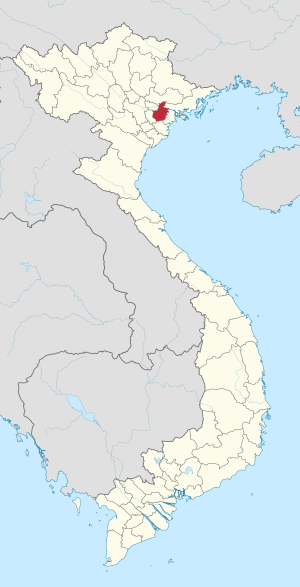
Location of Hải Dương within Vietnam
|
|
| Country | |
| Region | Red River Delta |
| Capital | Hải Dương |
| Area | |
| • Total | 1,648.4 km2 (636.5 sq mi) |
| Population | |
| • Total | 1,936,800 |
| • Density | 1,174.96/km2 (3,043.13/sq mi) |
| Demographics | |
| • Ethnicities | Vietnamese, Sán Dìu, Mường, Tày, Nùng, Hoa |
| Time zone | UTC+7 (ICT) |
| Area codes | 220 |
| ISO 3166 code | VN-61 |
| Website | |
Hải Dương (Vietnamese: [haːj˧˩ zɨəŋ˧˧]) is a province in northern Vietnam. It is part of the Red River Delta region. The name Hải Dương means "ocean sun" in an old Vietnamese language. Even though its name suggests the ocean, the province is actually surrounded by land. Hải Dương is known for its strong economy, especially in making things in factories.
Contents
- What's in a Name? The Meaning of Hải Dương
- Exploring Hải Dương's Geography
- How Hải Dương is Organized: Administrative Divisions
- Hải Dương's Climate: Seasons and Weather
- Understanding Hải Dương's Population
- A Look at Hải Dương's History
- Hải Dương's Economy: Making and Growing Things
- Population and New City Areas
- Education System in Hải Dương
- Public Health and Safety
- Transportation: Getting Around Hải Dương
- Media, Culture, and Fun in Hải Dương
- See also
What's in a Name? The Meaning of Hải Dương
The name Hải Dương comes from old Vietnamese words meaning "ocean sun." This name was first used officially in 1498. Long ago, Hải Dương was a very large area. It stretched from east of Hanoi all the way to the South China Sea. Today, this old area includes modern Hải Dương, Hải Phòng, most of Hưng Yên, and a small part of Quảng Ninh.
Exploring Hải Dương's Geography
Hải Dương province is located in the Red River Delta in northeastern Vietnam. It sits about halfway between the big cities of Hanoi and Haiphong. The province is famous for two beautiful pagodas, Côn Sơn and Kiếp Bạc. It is also well-known for its delicious lychees and a traditional sweet treat called bánh đậu xanh (mung bean paste).
Hải Dương covers an area of about 1,661 square kilometers. This makes it the 51st largest province in Vietnam. It shares its borders with six other provinces. These include Bắc Ninh, Bắc Giang, and Quảng Ninh to the north. To the west is Hưng Yên, to the east is Hải Phòng, and to the south is Thái Bình. Important roads and railways, like Highways No. 5, No. 18, No. 183, and No. 37, run through the province.
How Hải Dương is Organized: Administrative Divisions
Hải Dương province is divided into 12 main areas. These include 9 districts, 1 district-level town, and 2 provincial cities. The capital city of the province is Hải Dương.
- 9 districts:
- Bình Giang
- Cẩm Giàng
- Gia Lộc
- Kim Thành
- Nam Sách
- Ninh Giang
- Thanh Hà
- Thanh Miện
- Tứ Kỳ
- 1 district-level town:
- Kinh Môn
- 2 provincial cities:
- Chí Linh
- Hải Dương (the capital)
These areas are further divided into smaller towns, communes, and wards.
Hải Dương's Climate: Seasons and Weather
Hải Dương has a tropical monsoon climate. This means it has a cold winter, warm weather, and lots of humidity. The winds usually blow from the southeast and northeast. The year is divided into four clear seasons.
From early February to early April, there is a time of transition. It's between the dry and wet seasons, with some mist and rain. The main rainy season lasts from April to October. The province gets between 1300 mm and 1700 mm of rain each year. The average temperature is about 23.3°C. On average, the sun shines for 1,524 hours each year. The air is usually quite humid, between 85% and 87%.
Understanding Hải Dương's Population
Over the past 20 years, Hải Dương province has seen big changes in its population. The number of births has gone down a lot. The death rate has also decreased. This is because of successful family planning and better healthcare. People are also living longer. These changes have happened much faster than in many other parts of the world.
In 2010, about 600,000 people in Hải Dương were 60 years old or older. By 2050, this number is expected to grow to nearly 800,000. At that time, there will be as many older people as there are children under 15.
Most people in Hải Dương are Kinh, making up 99% of the population. Other groups include Sán Dìu, Mường, Tày, Nùng, and Hoa. Many different religions are practiced, such as Buddhism and Catholicism. However, honoring ancestors is a very common practice for many people.
A Look at Hải Dương's History
Hải Dương is located in the Red River Delta, a very old and important area. The region has had many different names throughout history. Some of these names include Dương Tuyền, Giao Chỉ, Hồng Châu, and Thừa tuyên.
Hải Dương province was officially created in 1831. It was first called "Thành Đông," which means "the city to the east of Thăng Long citadel." In the early 1900s, people in Hải Dương joined movements to gain independence. In the 1930s, the people of Hải Dương fought against foreign rule and won.
In 1968, Hải Dương was combined with Hưng Yên to form Hải Hưng Province. Then, in January 1997, Hải Hưng was split back into Hải Dương and Hưng Yên provinces. In August 1997, Hải Dương was upgraded from a town to a city. Since 1997, Hải Dương province has had 11 districts and one city.
Hải Dương's Economy: Making and Growing Things
Hải Dương province is part of Vietnam's important Northern Key Economic Region. It has a strong economy that focuses on making things in factories.
The province is in the middle of the Red River Delta. This location is great for transportation, farming, and industry. Hải Dương plays a big role in Vietnam's economic growth. Over 800,000 people out of 1.7 million have jobs. More than 500,000 of these work in farming.
Hải Dương has focused on growing its farming and industrial production. The province has received money from both inside Vietnam and from other countries. Businesses from places like Britain, Germany, France, and Hong Kong have invested here. Hải Dương also works to make its farming more modern and efficient.
For many years, Hải Dương has sent special products to big cities like Hanoi and Haiphong. These products include lychees and traditional green bean cakes. Farming in Hải Dương has grown quickly and steadily in recent years.
Population and New City Areas
Hải Dương's Population Numbers
According to information from 2008, Hải Dương covers 1,651.8 square kilometers. It had a population of 1,732,814 people. This means there were about 1,049 people per square kilometer.
Here's how the population was divided in 2007:
- By gender: 842,002 males and 890,812 females.
- By location: 279,850 people lived in cities, and 1,452,964 lived in rural areas.
The population growth rate for the whole province was 9.60%. For urban areas, it was 10.38%, and for rural areas, it was 9.50%. About 1,094,272 people were of working age.
New Urban Areas in Hải Dương City
Hải Dương City now has two new urban areas. The first one is in eastern Hải Dương. It covers 108 hectares and includes two wards: Ngọc Châu and Hải Tân. The second new area is in western Hải Dương. It covers 433 hectares and is in Thanh Bình ward and Tứ Minh commune.
Many families now live in these new areas. However, the cost of land and building homes there is quite high compared to the average living costs in Hải Dương. These new urban areas helped Hải Dương City become a "second level city" on May 16, 2009.
Education System in Hải Dương
Hải Dương's education system has five main stages. These are pre-primary, primary, intermediate, secondary, and higher education. This follows the national education system of Vietnam.
- Pre-primary: This is for children aged 2 to 5 years old. It helps them develop their thinking and daily habits. Not all children have to attend this level.
- Primary school: This starts at age 6 and lasts for 5 years (grades 1 to 5). It is required for all students.
- Intermediate school: This includes grades 6 to 9. Students learn subjects like Math, Physics, Chemistry, Biology, Computer Science, Vietnamese language, History, Geography, and more. Students must pass an exam to go to higher levels.
- Secondary school: This covers grades 10 to 12. To graduate, students must pass a special exam. Students also learn subjects similar to intermediate school, plus other activities like business and vocational training.
Hải Dương province has many schools and education centers. Here's a quick look at the numbers:
| District (city/town) | Preschools | Elementary schools | Junior high schools | Secondary schools | Colleges | Universities |
| Bình Giang | 19 | 18 | 19 | 3 | ||
| Cẩm Giàng | 19 | 21 | 20 | 3 | 1 | |
| Chí Linh city | 27 | 22 | 20 | 4 | 1 | |
| Gia Lộc | 25 | 25 | 26 | 3 | ||
| Hải Dương city | 18 | 18 | 15 | 6 | 5 | 1 |
| Kim Thành | 22 | 24 | 21 | 4 | ||
| Kinh Môn town | 27 | 27 | 27 | 5 | ||
| Nam Sách | 25 | 24 | 25 | 5 | ||
| Ninh Giang | 24 | 28 | 29 | 5 | ||
| Thanh Hà | 25 | 25 | 26 | 4 | ||
| Thanh Miện | 20 | 19 | 20 | 3 | ||
| Tứ Kỳ | 29 | 29 | 27 | 4 |
Public Health and Safety
Hải Dương was one of the first provinces in Vietnam to start a public safety program for children. A special safety site for children was built in Đức Chính village. After just one year, the number of accidents and injuries among children went down a lot. This shows the program had a good effect. Hải Dương city also has a public general hospital on Nguyễn Lương Bằng street.
Transportation: Getting Around Hải Dương
Just a few years ago, it took a long time to transport farm products from Hải Dương to Hanoi. Now, it only takes about an hour! This big improvement is thanks to the amazing development of the transportation network.
Roads in Hải Dương province have improved very quickly. In the last 5 years, many roads have been upgraded. For example, National Road No. 5, which connects Hanoi and Haiphong, was made into a first-class road in 1999.
Today, Hải Dương has 649 kilometers of main roads. These include National Roads No. 5, 18, 183, and 37. These roads make it easy to travel and move goods within the province. There are also 11 provincial asphalt roads, totaling 258 kilometers, and 27 district-level roads, totaling 352 kilometers. About 70% of these district roads are now paved with asphalt.
Hải Dương also has many waterways, with nearly 300 kilometers of rivers and canals. There are also 70 kilometers of railway lines, including some for a local company.
Media, Culture, and Fun in Hải Dương
Hải Dương has its own provincial newspaper, which publishes daily, weekend, and monthly editions. There are also magazines from different government departments. Online newspapers, like www.haiduong.gov.vn, make it easy to get news about the province.
The Hải Dương Provincial People's Voice and Television Broadcasting Center is one of the best in northern Vietnam. Cable TV is also available, offering many international channels.
Hải Dương is known as a "sacred land with pre-eminent people." It has hundreds of famous historical and cultural sites. These include Côn Sơn - Kiếp Bạc, Nguyễn Trãi Temple, and Chi Lăng Nam Storks island. The province also has many traditional craft villages that make well-known products. Cultural festivals are held every spring and autumn, bringing visitors from all over the country.
Hải Dương has over 100 hotels, from 2-star to 4-star, plus many motels and guesthouses. You can find restaurants serving traditional food on almost every street in the city center. Visitors can also enjoy Chinese, Korean, and Japanese food at special restaurants around Bạch Đằng Lake.
Delicious Food: Hải Dương's Cuisine
When you visit Hải Dương, be sure to try some local specialties! These include Bánh đậu xanh, a sweet cake made from mung beans, and Rượu Phú Lộc, a local wine.
See also
 In Spanish: Provincia de Hải Dương para niños
In Spanish: Provincia de Hải Dương para niños



